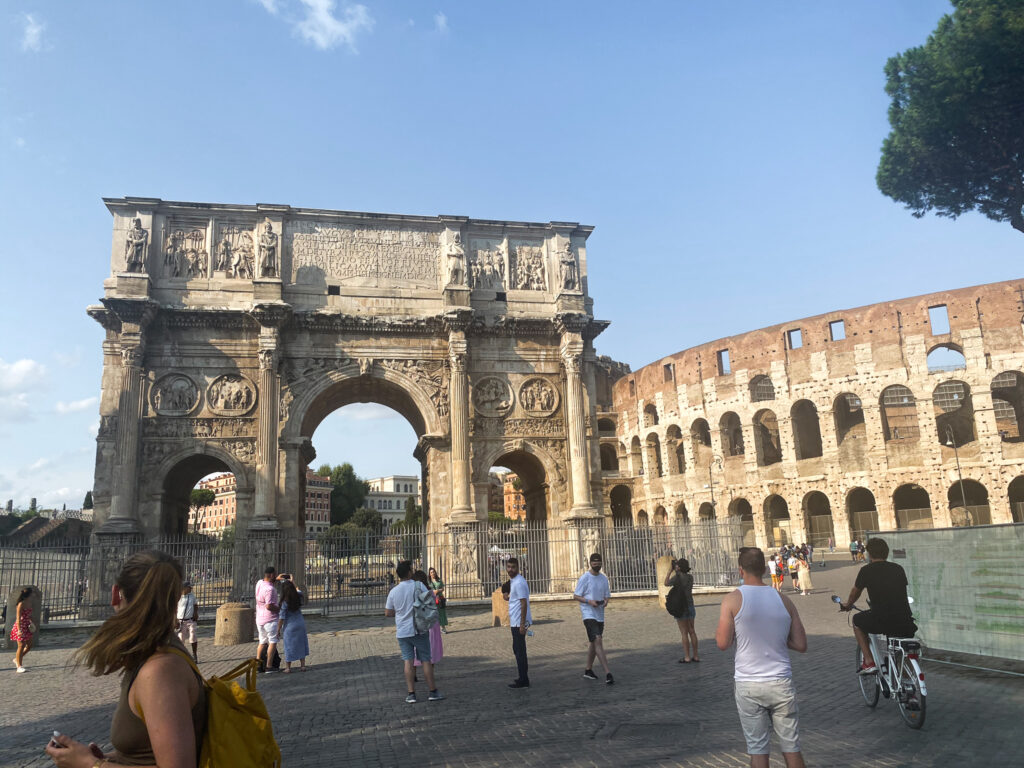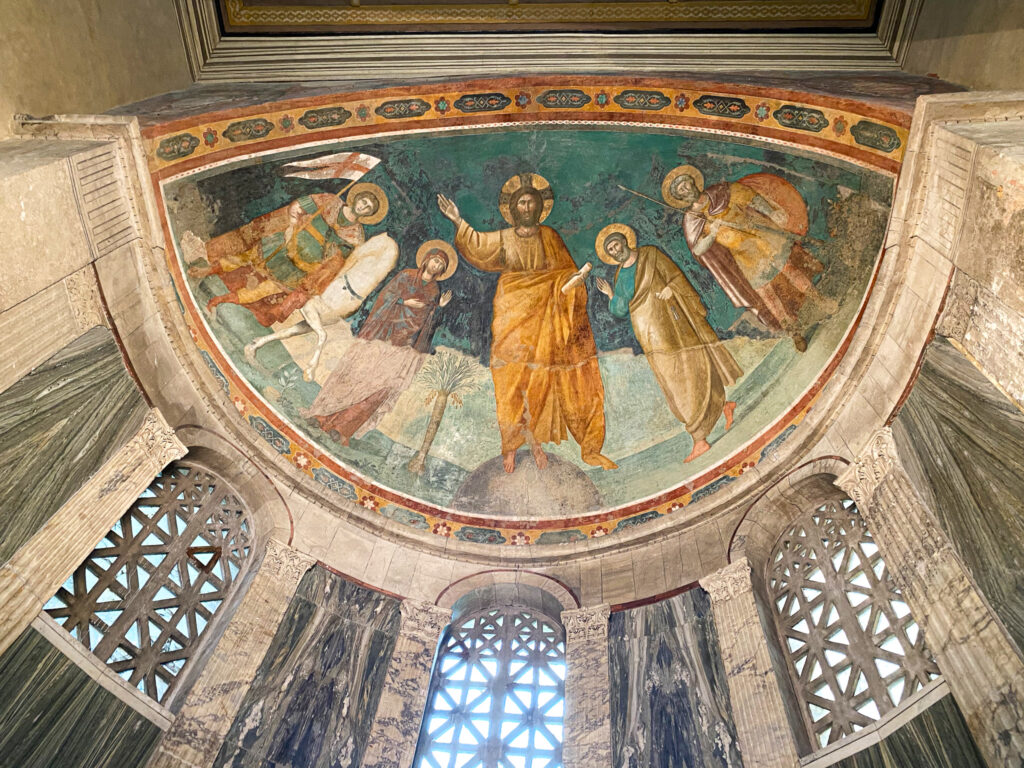It was difficult, and even sad, to finish our first year without getting to know classmates and without the opportunity of experiencing and sharing ours studies with others. So the offer of an excursion to Rome at the end of summer was not only a welcome addition to the summer holidays, but also an opportunity for us to finally step out from behind our computers and get to know each other in person. In the end, perhaps partly due to the fear of hot Roman weather and partly due to other circumstances, our group was small, but full of enthusiasm and a desire to explore Rome properly.

Italy welcomed us with clear blue skies and really hot weather, however, we were not going to spend our valuable days in Rome in vain, so after landing, we went straight to our first Roman sight. At first glance, the small church seemed quite ordinary, and there weren’t many people around it. But we knew that amazing mosaics from the fifth century awaited us inside. This was the church of Santa Pudenziana. Our obvious interest in art and the fact that we were not just tourists, but art students, softened the local warden, and he let us go to the upper floor, which is usually closed. From that point of view, it was possible to see the mosaics from a breathtaking proximity, and there we also saw slightly younger medieval frescoes.
In the early afternoon, most Roman churches are closed, so we used this time to have lunch in a traditional Italian restaurant. But we still had lots of places to visit in our program, so with renewed vigor, after lunch and Italian espresso, we took off to see the next sights. We remembered the mosaics from Santa Maria Maggiore and the basilica of Santi Cosma and Damiano well from lectures, but our actual encounter with them was surprising for us. The complicated scenes in Santa Maria Maggiore were difficult to see from the aisles, while the figures of the saints in the basilica of Santi Cosma and Damiano were so close that we could admire the design and size of the tesserae.
Our next visit was disrupted by a wedding taking place in the church of Santa Maria Nova, so we decided to take a longer walk to the church of Santa Sabina instead. Along the way, we passed the Arch of Constantine, well known from any first lecture on medieval art. Santa Sabina amazed us with a fifth-century wooden door and simple interior. Lowering temperatures told us that evening was coming, so we left art for the next day and went for a delicious Neapolitan pizza.
The next day, we started with a longer walk behind the city walls. It was chilly in the morning, so the walk was comfortable, even though it took almost an hour. However, our main destination, the Mausoleum of Constance, would have been worth an even longer walk. Plus, we were completely alone in the impressive circular space throughout our visit, which allowed us to study every little detail carefully and walk the entire length and breadth of the space. The adjacent church of St. Agnes gave us a view of completely different mosaics than what we had seen in the morning and the day before. However, the simple aesthetics of the seventh century were also fascinating, so we spent quite a lot of time in the basilica, again undisturbed by other visitors.
When it was time for an aperitif and lunch, the Roman sky clouded over us. However, our afternoon destination was the underground catacombs, so the change in weather didn’t bother us so much. Although we arrived for the tour a little late, fortunately the Italian guide was still waiting for us and willingly took us to the depths of the underground. Simple drawings of the earliest Christians, together with tombs of various sizes, aroused different emotions in us, which were further accentuated by the fact that we were able to look into a part normally closed to tourists.
The rain caught us as we hurried from the catacombs to the Lateran. It rained so hard that we had to hide in a niche near a Vietnamese restaurant. However, its owner took pity on us and let us in. To our surprise, after a while, he approached us with uncertain Czech to tell us that he had lived and worked in Brno for some time.

During a break in the rain, we managed to run to the Lateran, but part of it was closed and the view of the mosaics in San Venanzio was spoiled by a tastelessly located modern altar. The lady from the church looked grumpy at first, but she let us look at the mosaics in the side room. We concluded our day, at least the sightseeing part, with the Lateran. The rest of the evening we spent under the Italian sky, talking and drinking wine.
On the third morning, the incredible luck we had had before left us a little. The church of St. Clement did not open at nine, but an hour later, and although we tried to fill the time by visiting another church, we were not successful. So we had coffee and returned to Clement at ten, admiring the golden mosaics from the twelfth century. However, we were more interested in the blue tesserae in St. Prassede, which subtly copy the iconography of St. Cosma and Damiano and also the adjacent chapel of St. Zenon. Unfortunately, our troubles with opening hours continued, which is why we spent a lot of the third day on our feet. Of course, these small problems did not spoil the joy of encountering other breathtaking sights. At noon, when all the churches were closed, we took a walk to a lookout. There, we understood that, despite our intense exploration of churches in the two days prior, we still couldn’t recognize them by the rooftops.
In the afternoon, we managed to visit the churches of San Giorgio, Santa Maria Nova, with one of the oldest icons in Rome, the underground at San Crisogono, San Marco, and a took a quick look at Santa Maria Trastevere, where the mass was just taking place. In addition to the repetitive and yet diverse mosaics in the apses and the reunion with Pope Pascal, under whose pontificate some works were created, it was extremely interesting for us to observe the frescoes by Cavallini. After admiring his depiction of the Last Judgment, we could not help but wonder why most Roman tourists head for Michelangelo’s Pieta, instead of looking at this gem.
We could not end an intensive visit to Rome with anything other than a proper Italian dinner. Enjoying delicious pasta, we were a bit melancholy that our beautiful trip was over. But it was clear to all of us that this wasn’t the last time we’d see The Eternal City and that we would hopefully return there soon.



